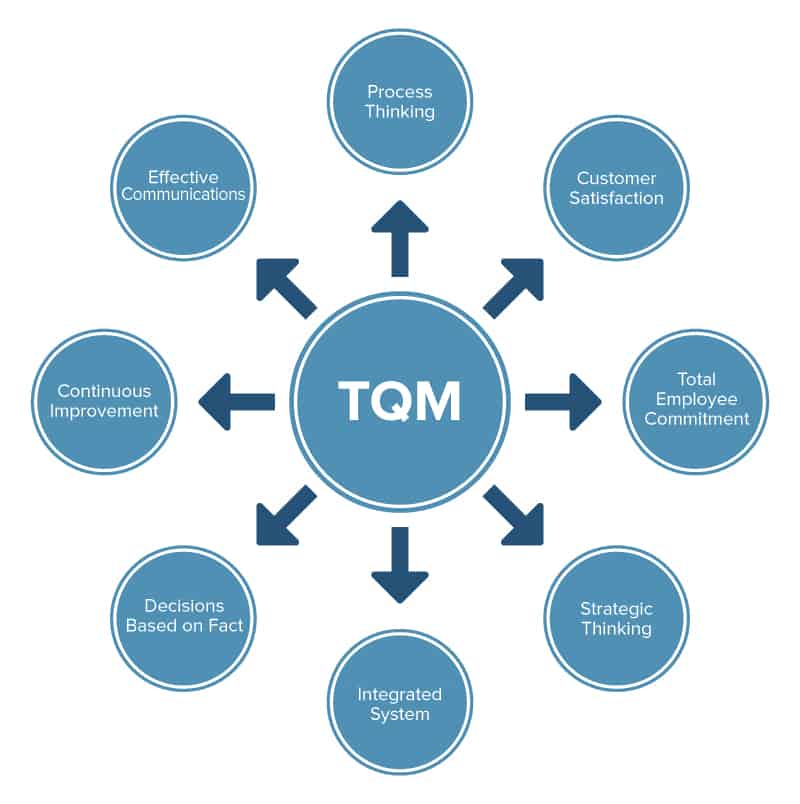What Is Total Quality Management?
Total quality management (TQM) describes a management system wherein a company attains organizational advancement through a commitment to customer requirements. A company meets those requirements when it empowers every employee in every department to maintain high standards and strive for continuous improvement. Total quality management is the predecessor of many quality management systems, such as Six Sigma, Lean, and ISO.
What Is Quality Management?
First, what is quality? It is a measure of the level of acceptability of a product or service. The ASQ Quality Glossary defines quality management as “the application of a quality management system in managing a process to achieve maximum customer satisfaction at the lowest overall cost to the organization while continuing to improve the process.” Quality management has four parts: quality planning, quality assurance (defect prevention), quality control (which includes product inspection and other elements, such as competence), and quality improvement.
Why would it take until the 20th century to apply such seemingly obvious principles like product goals and parts inspection? Perhaps the right historical circumstances didn’t present themselves until the 20th century. Nichols credits new mass-production techniques, such as Ford’s assembly line, and the urgent demand for materials during two world wars for this particular innovation. “The US military demanded to some extent that every product they purchased be good because soldiers lives literally depended on the quality of the products they handled,” says Nichols. “Whether it was for K rations or bullets, these wars spurred a manufacturing revolution to focus on the idea of getting things right every time.”
Statistics play an integral part in quality management because being able to predict accuracy through numbers is much less expensive than inspecting parts. Moreover, sometimes inspection is simply inconvenient. “McDonald's needs to know that every burger is right without having to take a bite out of each one,” says Nichols.
Total Quality Management Principles
No single accepted body of knowledge exists for total quality management, as does, for example, the Project Management Body of Knowledge (PMBOK) for the Project Management Institute. Similarly, no prescribed actions exist for implementing TQM methods and tools. Organizations have been free to deploy and adapt TQM as they see fit, giving way to many definitions of the methodology. Despite these challenges to standardization, it’s possible to describe generally accepted principles:
- Customer Satisfaction
- Employee Commitment: This creates empowerment through training and suggestion mechanisms.
- Fact-Based Decision Making: Teams collect data and process statistics to ensure that work meets specifications.
- Effective Communications: There should be an open dialogue throughout an organization.
- Strategic Thinking: Quality must be part of an organization’s long-term vision.
- Integrated System: A shared vision, including knowledge of and commitment to principles of quality, keep everyone in a company connected. Taiichi Ohno recognized that even suppliers are an important part of the system.
- Process-Centered: You can deconstruct every activity into processes, and, therefore, locate and repeat the best process.
- Continuous Improvement: Every employee should always be thinking about how to better perform their job.
You could sum up the goal of TQM in this way: “Do things right the first time, every time.”
The History of Total Quality Management
There is no single, agreed-upon source for the phrase total quality management. Some experts believe it came from two books by seminal quality management thinkers: Armand Feigenbaum’s Total Quality Control and Kaoru Ishikawa's What Is Total Quality Control? The Japanese Way. Others say the terminology arose from an initiative in the United States Navy to adopt quality management guru William Deming’s recommendations, which they termed total quality management. TQM did not enjoy widespread acceptance until the 1980s.
The roots of the principles and practice of TQM extend back to the early 20th century and Frederick Taylor’s Principles of Scientific Management, which advocated a consistent way of performing tasks and inspecting finished work to prevent defective products from leaving the shop. Further innovation came in the 1920s with Walter Shewhart’s elaboration of statistical process controls, which one could apply at any point in the production process to predict quality levels. It was Shewhart who developed the control chart, used today for managing with Kanban and Agile.
Throughout the 20s and 30s, Shewhart’s friend and mentee, William Deming, developed statistical process control theories that he would eventually use to help the US Census department in the early 1940s. This was the first use of statistical process control in a non-manufacturing field.
The Beginning of the Quality Era in Japan
After the war, other American quality theorists, including Deming, who would achieve hero status in Japan, advised Japanese industry on how to improve processes and output to rebuild their war-shattered economy. At the time, the term made in Japan was synonymous with shoddy craftsmanship. As early as 1945, such visionaries as electrical engineer Homer Sarasohn spoke about controlling variation and monitoring process to produce better deliverables.
As a result, in the 1950s, quality became the byword for Japanese manufacturing. Quality concerned not just management, but all levels of a company. In the 1960s, quality circles began appearing in Japanese workplaces to allow employees the opportunity to discuss problems and consider solutions, which they then presented to management. Starting on the factory floor, quality circles spread to other functional departments. The company-wide focus on quality may also provide a clue to the origin of the phrase total quality.
Total Quality Management in the USA
By the 1970s, the term made in the USA was no longer a badge of pride. Since the end of WWII, the main effort in American factories was to produce a large quantity of items, maintain the production schedule, and save money. Usability and durability seldom mattered until concerns about lack of product quality reached a fever pitch. As Japan successfully challenged the United States for industrial leadership, US industry now took a page from Japan’s quality-improvement book. A new interest in quality management took hold, building on the work of Shewhart’s disciples, such as Deming, Josef Juran, and Kaoru Ishikawa in Japan. Influential businessmen like Philip Crosby championed the trend.
Although the growth of TQM seems to have occurred exclusively within the precincts of industry, the basic outlines of the concept owe much to a 1980s US Navy project that used Shewhart and Deming’s PDCA (plan, do, check, act) model. Navy guidelines articulated the principles that customer requirements should define quality and continuous improvement should pervade an entire organization. Navy success with the methodology led to TQM’s adoption by other armed services, such as the army and coast guard, and eventually the rest of the US government. Congress established the Federal Quality Institute in 1988 to highlight the need for quality management in business and reward organizations for successful implementations.
Total Quality Management Meets the World
Quality management began in manufacturing, and TQM, like it’s subsequent methodologies, adapted well to finance, healthcare, and other fields. Some of the landmark companies to adopt TQM include Toyota, Ford, and Philips Semiconductors.
Worldwide, countries such as Germany, France, the UK, and Turkey established TQM standards. But by the 1990s, TQM was superseded by ISO (International Standards Organization), which became the standard for much of continental Europe, and by another methodological response of the 1980s to quality concerns, Six Sigma. Nevertheless, TQM principles form the basis for much of ISO and Six Sigma. For example, PDCA appears under the Six Sigma method DMAIC (define, measure, analyze, improve, control). And in the 2000s, the ISO governing body recognized TQM as a foundational philosophy. TQM lives on in data-driven methods for a data-driven age.
William Deming and the Origin of Total Quality Management
Much of our current understanding of the value and pursuit of quality traces back to William Deming. This American statistician, engineer, and management consultant laid many foundations for the use of statistics in production and work management. He introduced statistical process methods to the US Census Bureau in the early 1940s, marking the first time they were used in the business or service sector. During WWII, he advised US business and government on statistical methods to help with planning for wartime manufacturing. After the war, Deming was recruited by no less than General Douglas MacArthur to advise Japanese officials on census models to assess war damage and plan for rebuilding.
Deming distinguished himself among many of the occupying forces by showing a genuine interest in Japan and its culture. Perhaps it’s not surprising, then, that the Japanese revere him for his role in midwifing the Japanese economic miracle.
Because Japan lacked abundant natural resources, Japanese leaders viewed the exportation of goods worldwide as their main path to financial success. Their post-war reputation for low-quality products posed a particular challenge to this goal. Deming was invited back to Japan by the Union of Japanese Scientists and Engineers (JUSE), whose president was Kaoru Ishikawa, to discuss quality management, ideas that formed the basis for what later became known as TQM. Japanese products were gradually recognized for usability and durability. In 1960, for his efforts on behalf of Japanese industry, Deming received the Second Order Medal of the Sacred Treasure from the Emperor of Japan. By the 1970s, Japanese exports surpassed those of the United States.
By contrast, American goods gained a reputation for poor design and defects. As early as 1940, Juran remarked that producing goods and meeting deadlines took priority, with quality being relegated to the final inspection. Deming believed that as soon as the war was over, US industry lost interest in statistical methods for pursuing quality. Ironically, it was Deming who, in the late 70s and early 80s, introduced the US and the UK to the quality management principles he’d taught in Japan 30 years earlier. In 1967, he published the article “What Happened In Japan?” in the journal Industrial Quality Control. Professionals consider it to be an early version of his famous 14 Points and PDCA cycle.
Although well-known in academic quality control circles, he achieved greater prominence when he was interviewed for the 1980 NBC documentary “If Japan Can, Why Can’t We?” In the program, Deming emphasized that, “If you get gains in productivity, it is only because people work smarter, not harder. That is total profit, and it multiplies several times.” The documentary revealed another act in Deming’s life, that of a sought-after quality consultant to American business. He gained a reputation for bluntness and fearlessness in the presence of senior executives. Legend has it he told senior Ford staff that 85 percent of quality issues resulted from poor management decisions. Some companies rejected him. However, on his advice, Ford conducted user surveys before designing and building the Ford Taurus. In 1992, the Taurus became the number one selling car in the US.
In his 1986 book, Out of the Crisis, he discussed his 14 Points for Management. The following year, at the age of 87, he was awarded the National Medal of Technology. In 1993, the year of his death, he established the Deming Institute.
Why Is Total Quality Management Important to an Organization?
Nichols says that TQM tools and principles acquire power not when an organization creates a dedicated quality department, but when it includes the whole company in the pursuit of high quality. An example is the quality circle, in which workers directly involved in a process brainstorm to discover solutions. “People are a fabulous resource that is frequently underutilized. The leadership often doesn’t recognize the value that they bring to the everyday workplace. Employees know how to fix problems,” asserts Nichols. In addition to tapping a native resource, implementing a TQM philosophy can help an organization:
- Ensure customer satisfaction and customer loyalty
- Ensure increased revenues and higher productivity
- Reduce waste and inventory
- Improve design
- Adapt to changing markets and regulatory environments
- Increase productivity
- Enhance market image
- Eliminate defects and waste
- Increase job security
- Improve employee morale
- Reduce costs
- Increase profitability
What Are the Costs of Quality?
A fundamental tenet of TQM is that the cost of doing things right the first time is far less than the potential cost of re-doing things. There are also residual losses when customers abandon products and brands for quality reasons. Some schools of thought view quality as having a cost which cannot be recouped. Juran, Deming, and Feigenbaum held a different view. For advocates of TQM, the cost of quality really describes the cost of not creating a quality deliverable. There are four primary cost categories:
- Appraisal Costs: Appraisal costs cover inspection and testing throughout the production cycle. This includes verifying that the materials received from the supplier meet specifications and ensuring that products are acceptable at each stage of production.
- Prevention Costs: Prevention costs include proper setup of work areas for efficiency and safety, and proper training and planning. This type of cost also includes conducting reviews. Prevention-related activities often receive the smallest allocation of a company’s budget.
- External Failure Costs: This category concerns the cost of issues following a product’s market release. They may include warranty issues, product recalls, returns, and repairs.
- Internal Failure Costs: Internal failures are the costs of problems before products reach customers. Examples of internal failures include broken machines, which cause delay and downtime, poor materials, scrapped product runs, and designs that require rework.
Total Quality Management Models
Although TQM does not possess one universally recognized body of knowledge, organizations do pattern their efforts after a few formal models, including several industry entities and awards.
The Deming Application Prize was created in Japan in 1950 by the Union of Japanese Scientists and Engineers (JUSE) to acknowledge companies and individuals from around the world for their successful efforts at implementing TQM. Winners have included Ricoh, Toyota, Bridgestone Tire, and many others.
Congress established The Malcolm Baldrige National Quality Award (MBNQA) in 1987 to raise awareness of quality and reward US companies who pursue it. The National Institute of Standards and Technology (NIST) administers the award. It is given to large and small companies and nonprofit entities that demonstrate excellent performance in the following areas:
- Delivery of increasing value to customers and stakeholders, contributing to organizational sustainability
- Improvement of overall organizational effectiveness and capabilities
- Implementation of organizational and personal learning
Past winners have included the Chugach School District, Concordia Publishing House, and Boeing Mobility.
The nonprofit European Foundation for Quality Management (EFQM) was established in 1989 to provide a quality framework for organizations throughout Europe. They maintain the EFQM excellence model, which embraces the following precepts:
- Adding value for customers
- Creating a sustainable future
- Developing organizational capability
- Harnessing creativity and innovation
- Leading with vision, inspiration, and integrity
- Managing with agility
- Succeeding through the talent of people
- Sustaining outstanding results
Participating organizations can partake of training and assessment tools and may apply for the EFQM Excellence Award.
The International Organization for Standards (ISO 9000) publishes guidelines and specifications for parts, processes, and even documentation to ensure that quality is consistent across companies, organizations, and borders.
How Do You Implement Total Quality Management?
PDCA lies at the core of many 20th century quality efforts. PDCA began in the 1920s as a conception by engineer and statistician Walter Shewhart. It was originally called PDSA (plan, do, study, act). Widely disseminated by Deming, who referred to it as the Shewhart cycle, it is now often referred to as the Deming cycle.
“Plan: The planning phase is the most important. That’s where management, along with the associates, identify the problems to see what really needs to be addressed — the day-to-day things that may be happening on the productivity side that management is not aware of. So they’re trying to determine a root cause. Sometimes, employees do research or high-level tracking to narrow down where an issue may originate.
Do: The doing phase is the solution phase. Strategies are developed to try to fix those problems identified in the planning phase. Employees may implement solutions and if a solution doesn’t appear to work, it’s back to the drawing board. In contrast to Six Sigma, it’s less about measuring gains and more about whether the employees judge the solution to be working.
Check: The checking phase is the before and after. So after you’ve made these changes, you see how they’re doing.
Act: The acting phase is the presentation or the documentation of the results to let everybody know, ‘Hey, here’s how we were doing it. Here’s how it is now. This is the new way, and this is what this should address going forward.’”
Nichols says that in 2000, ISO acknowledged PDCA as a foundational method. It appears again in Six Sigma as the DMAIC method (define, measure, analyze, improve, and control). Walters notes that TQM is much more people oriented, while Six Sigma is process based. He sees, for example, that the term define “takes the human element out” and the term measure focuses on data.
Total Quality Management, Kaizen, and Six Sigma: Which One When?
While TQM’s method of using employees as a source of ideas and solutions can help companies, Six Sigma’s process and measurement focus — which promotes data-driven decisions — offers compelling benefits. Walters uses the example of producing peanut butter and jelly sandwiches.
“We’d start out with two pieces of bread, add the peanut butter, add the jelly, and put the two pieces of bread together. But, maybe the edges are smashed together. Maybe the corners are damaged. Or, when our customers get it, they say the bread is soggy. Within that process, we’re not sure whether we’re putting on too much jelly or whether we’re using the wrong type of peanut butter. You just don’t know what it is, so you have these group meetings and brainstorm until your customer response is what you want, and the level of acceptance of your quote unquote quality product is where you desire it to be,” says Walters.
With Six Sigma, however, the questioning process would drill down to the details. What kind of bread were you using? What kind of peanut butter? What kind of jelly?
“That to me is the benefit because it takes the onus off the people and focuses strictly on the process,” asserts Walters. “So, if we tighten up the process, we can feel like we already have quality people. And after the process is repeating in the same manner, even if there are other performance issues, that automatically sets you back to the human side. But then you can manage the human issue properly because you don’t have to worry about your processes. Your numbers aren’t changing.”
Walters states further that most companies want to develop brand loyalty, even if their product is essentially the same as a competitor’s. “If we use TQM, we hope a product is of better quality, so you’ll come back. With TQM, you have to wait for your customers to confirm that it’s good. With Six Sigma, at the end of the day, you don’t guess if your product is better. You know it. If you properly identify your market and your product has the best fit for the niche, you know you have the best product from a process perspective. That leads to the deeper relationships,” he says.
If Six Sigma can offer definitive results for an existing process and TQM can help achieve results over time, where does Kaizen fit? Kaizen is a Japanese word meaning philosophy of improvement. It includes the 5 Ss, seiri, seiton, seiso, Seiketsu, and shitsuke, translated loosely into English as sort, set in order, shine, standardize, and sustain. Kaizen is considered more of a philosophy for how to organize your workspace and the larger workplace and how to have the right attitude toward your work and coworkers.
Kaizen events are improvement efforts that involve small teams that spend a short time, usually about a week, considering and testing improvements. The team then presents its findings to management. Management periodically reviews the solutions to make sure that they continue to benefit the team.
Like TQM, Kaizen approaches efforts from the perspective that the whole company is responsible for quality and that improvement must be continuous. It is generally less methodological than Six Sigma, although Kaizen may inform the lean aspect of Lean Six Sigma.
The Seven Basic Tools of Total Quality Management
According to the experts, the basic tools of TQM allow anyone - even someone without statistical training - to gather data to illuminate most problems and reveal possible solutions. Here are the seven basic tools of TQM:
- Check Sheet: This is a pre-made form for gathering one type of data over time, so it’s only useful for frequently recurring data.
- Pareto Chart: The chart posits that 80 percent of problems are linked to 20 percent of causes. It helps you identify which problems fall into which categories.
- Cause and Effect Diagram or Ishikawa Diagram: This diagram allows you to visualize all possible causes of a problem or effect and then categorize them.
- Control Chart: This chart is a graphical description of how processes and results change over time.
- Histogram Bar Chart: This shows the frequency of a problem’s cause, as well as how and where results cluster.
- Scatter Diagram: This diagram plots data on the x and y axes to determine how results change as the variables change.
- Flow Chart or Stratification Diagram: This represents how different factors join in a process.
The Key Players in Total Quality Management: Customers, Suppliers, and Employees
To achieve success with a total quality management program or any other improvement methodology, managers must understand the quality goals for their product or company. They must then communicate those goals, in addition to the benefits of TQM, to the company, as employees play a vital role by contributing their intimate, day-to-day knowledge of product creation and processes.
TQM is a philosophy that values comprehensiveness. Therefore, suppliers are a crucial part of TQM execution. Companies must vet new suppliers and regularly audit existing suppliers to guarantee that materials meet standards. Communication with suppliers about TQM goals is also essential.
Customers are the most significant part of the TQM equation. After all, they’re the reason for TQM’s existence. Aside from the obvious feedback the sales team provides, customers — product or service users — give information about what they want from the deliverable, whether that deliverable is tangible or a service.
Certifications in Total Quality Management
Since its heyday in the 1980s and 1990s, TQM has been largely superseded by Six Sigma and ISO 9000. “The thing about Lean and Six Sigma is that they have a very definite set of methods to achieve these goals effectively. You go do x, y, and z,” explains Nichols. “ISO is a universal standard, and it’s clear what you have to do.Of course, what goes along with that is that you can be certified, which is outside the scope or remit of TQM,” concludes Nichols. He suggests that TQM lost traction in the UK because Europe adopted ISO in the 1990s. Today, formal TQM training is rare. Nichols suggests that companies with interest in pure TQM may pursue something like the Baldrige award.
Delivering Quality with Improved Processes in Smartsheet
Empower your people to go above and beyond with a flexible platform designed to match the needs of your team — and adapt as those needs change.
The Smartsheet platform makes it easy to plan, capture, manage, and report on work from anywhere, helping your team be more effective and get more done. Report on key metrics and get real-time visibility into work as it happens with roll-up reports, dashboards, and automated workflows built to keep your team connected and informed.
When teams have clarity into the work getting done, there’s no telling how much more they can accomplish in the same amount of time. Try Smartsheet for free, today.



